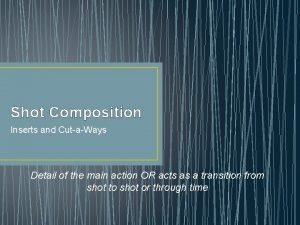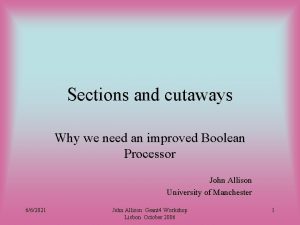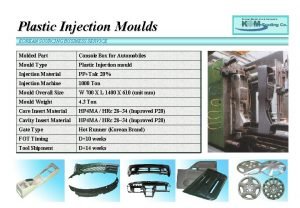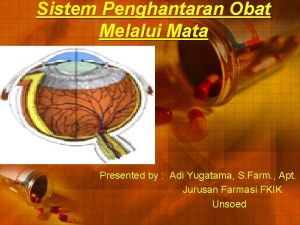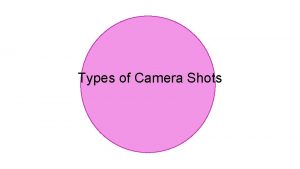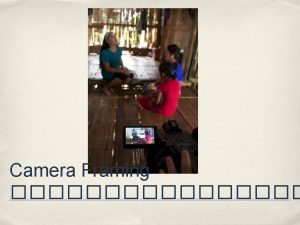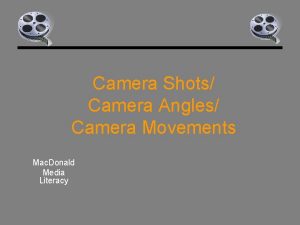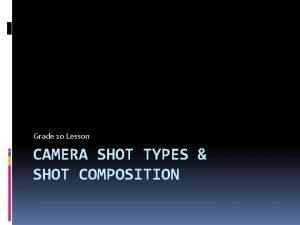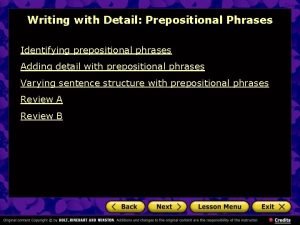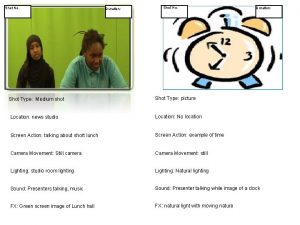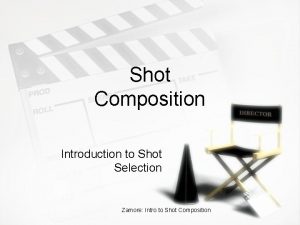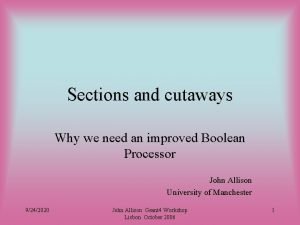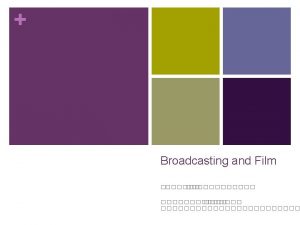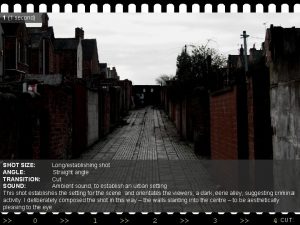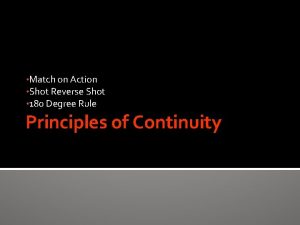Shot Composition Inserts and CutaWays Detail of the


















- Slides: 18

Shot Composition Inserts and Cut-a-Ways Detail of the main action OR acts as a transition from shot to shot or through time


In film, an insert is a shot of part of a scene as filmed from a different angle and/or focal length from the master shot. Inserts cover action already covered in the master shot, but emphasize a different aspect of that action due to the different framing. Insert

Insert Shot • Inserts cover action already covered in the master shot, but emphasize a different aspect of that action due to the different framing.

Insert • MAIN SHOT INSERT

Insert example • MAIN SHOT • INSERT

https: //www. youtube. com/watch? v=kc 8 ych 7 Ngeg Class Project on Inserts

In film and video, a cutaway shot is the interruption of a continuously filmed action by inserting a view of something else. It is usually, although not always, followed by a cut back to the first shot, when the cutaway avoids a jump cut. Cutaway

Cut away • In film and video, a cutaway shot is the interruption of a continuously filmed action by inserting a view of something else. It is usually, although not always, followed by a cut back to the first shot, when the cutaway avoids a jump cut.

Cutaway example • Shot away from main shot • During Interview with racecar driver. Including shot of racetrack • MAIN SHOT CUTAWAY

Types of Cuts

Hard Cut A standard cut, or hard cut is cutting from clip A to clip B as shown below. It is within the same scene, therefore the same location, so it doesn't confuse the viewer. This is why most hard cuts are contained within a scene and not used to go from scene to scene. In a hard cut, the most commonly used type of cut, you cut from clip A to clip B within the same scene.

Jump Cut A jump cuts from a frame in a clip to a later frame in the same clip (further in time) —or to a clip that looks very similar. The two shots below show what a jump cut looks like. In this example of a jump cut, the frames look similar because they’re from the same exact clip. The image on the right, however, comes from much later in the clip. In the stylistic format, a jump cut can mean one of two things: Passing time Repetition over time

Match Cut Match cut is a cut in film editing between either two different objects, two different spaces, or two different compositions in which objects in the two shots graphically match, often helping to establish a strong continuity of action and linking the two shots metaphorically.

Cutting on the Action The best kind of cut is one the viewers don’t see. Cutting on the action is the best way to hide a cut. Cutting on the action is exactly what it sounds like: When action spreads across two or more clips, the editor makes a cut in the middle of that action using a different camera angle or perspective (think combo shot). Notice how your eyes are drawn to movement—the man drinking. Cutting on the action means making your cut points in the middle of movements such as this.

A J-cut occurs when the audio from the next clip is heard before the video. An L-cut is when the video switches before the audio. The names of these cuts come from the shapes they make on the cutting timeline Click on the link below to view the Vimeo. Blog on the use and difference of J and L Cuts. J Cuts and L Cuts

J-Cut J-cut means you hear the audio before you see the video that matches with that audio. It doesn’t mean you’re staring at a black screen. It just means you’re looking at clip A while hearing the audio from clip B.

L-Cut L-cut means you’re still hearing the audio from a shot but you’re seeing a new shot. The viewer is looking at clip B while still hearing audio from clip A.
 What is a l cut
What is a l cut Cutaways and cross sections definition
Cutaways and cross sections definition Major details vs minor details
Major details vs minor details What is signal words
What is signal words Nozzle insert factory
Nozzle insert factory Tema standard for heat exchanger
Tema standard for heat exchanger Purchasing mould inserts service
Purchasing mould inserts service Mata kuliah sistem penghantaran obat
Mata kuliah sistem penghantaran obat Lifting inserts which are embedded or otherwise
Lifting inserts which are embedded or otherwise Bimetallic contact
Bimetallic contact Point of view shot example
Point of view shot example Wide shot camera
Wide shot camera Shot ws
Shot ws Subjective pov definition
Subjective pov definition Dramaturgiske model
Dramaturgiske model Wide shot medium shot close up
Wide shot medium shot close up Long shot camera angle
Long shot camera angle Mcu shot type
Mcu shot type Some prepositions show time and place and others add detail
Some prepositions show time and place and others add detail
